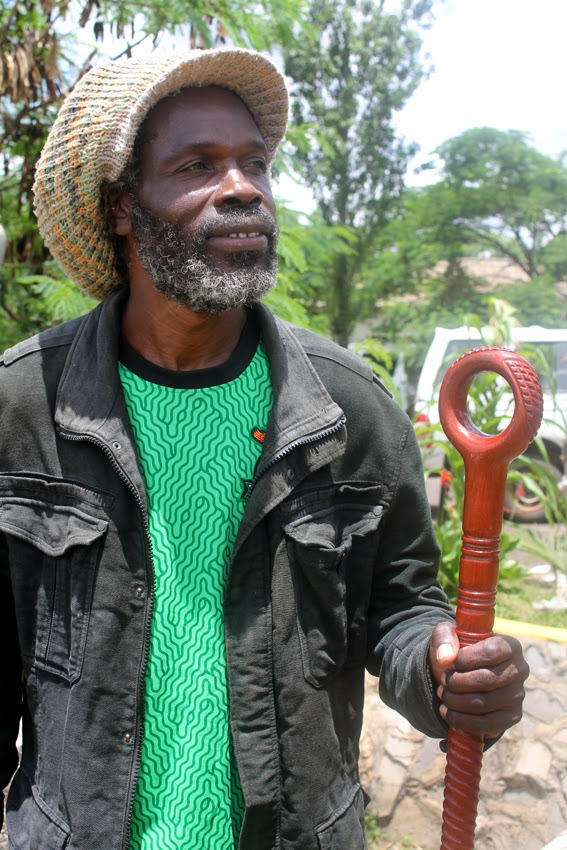By
Andrew Mulenga
The
movers and shakers of the city of Lusaka are not the coffee-sipping wannabes
that plague the ever mushrooming shopping malls or the smartphone-flashing
urban young professionals that literally have their eyes glued to these mobile
devices 24 hours a day.
It is
the street vendors, the call boys, the salaula
(used clothes) traders, the youth pushing a wheelbarrow and the little girl
selling fritters on the corner, they run this town. They are its heart beat; to
listen to their loudness is to place a stethoscope on its pulse as well as observe
the city’s very rhythm and this is what the snapshot painter Albert Kata does,
and does so well.
 |
| Market place, 2014, acrylic on canvas by Albert Kata |
“There
is a very good reason why I have chosen to paint daily life. Everything comes
to pass, nothing stays the same, so what I do is record, I keep memories, when
I paint this street scene and you come back here after five years it will not
be the same,” says the 53 year-old artist who lives and works from Kanyama
where he oversees the Kanyama Art Centre within the premises of the Kanyama
Youth Centre on Los Angeles Road just behind Lusaka City Market.
Evoking watercolours,
Kata’s paintings are slightly stylized realistic images that are brought to
life by his impeccable mastery of the colour wheel; it is clear that he does it
effortlessly and has been doing so for years. He also appears to do it with
such a conviction that one might suggest he has a passion for the hustle and bustle
of inner city and township life.
“As you
can see my compositions are detailed so obviously I have to work of
photographs, digital images, but you have to be careful because the crowds can
beat you up before they ask you where you are taking their photos. A good
strategy is to tell a friend to pose then you use an angle that will capture
the background,” he says.
 |
| Spectators, 2014, acrylic on canvas by Albert Kata |
But
although his work is vibrant and he is prolific in his work ethic churning out
one painting after the other, resulting in stacks of the work, he says at times
it becomes problematic when you make so much art because you end up with
nowhere to take it, no matter how good the quality is.
“The
challenges we face as Zambian artists is the market, there are limited places
to exhibit, and then also prices are too low. Look I spend two months on one
painting for some of the work then they don’t appreciate the effort or the
skill, so I’m thinking maybe I can start making small post cards, just for a
little money when its dry,” he cries.
Challenges
or not, it appears art is the life Kata has chosen, he lived, ate and breathed
it ever since his older brother introduced him to portrait drawing when he was
only grade 2 in the mining township of Mindolo in Kitwe the copperbelt
 |
| Water Crisis, 2014, acrylic on canvas by Albert Kata |
“Since
childhood I have never looked back. I went to Mindolo secondary but only up to
Form 3, I left school in 1980 and started doing some sign-writing jobs around
Kitwe with a few friends of mine, one of them was a safety inspector in the
mines it was a very respected position but he also used to paint murals on the
tunnel walls deep underground to warn miners against an underground cliff and
so on,” he recalls.
Because
he was from a mining family, in 1986 he was forced to join the Zambia Consolidated
Copper Mines (ZCCM) and undergo 6 months of training as a safety inspector, just
like his friend, but still his heart was with art.
“I was
finally employed at the Mindolo shaft in Wusakile, but then underground the
conditions are very bad, even when you don’t smoke you find yourself thirsty
for very strong tobacco so we used to smoke Guards (a cigarette brand) and
Kaponda (unprocessed tobacco),” he explains “but one day while we were smoking
underground we were standing at a certain place and I wasn’t comfortable
because I’m tall, so I told my workmates let’s move and stand where there is
more room, minutes after we moved a huge rock the size of a house fell right on
the place where we were previously standing my friends were surprised and said
this is a sign, I agreed and I took it as a sign for me to quit my job and go
back to art.”
 |
| Albert Kata - I preserve memories |
He went
home and told his parents that he had stopped work. They were not pleased so he
decided to leave Kitwe and travel to Lusaka because he heard this is where
artists were earning a decent living.
“In
Lusaka I met Mubanga, he was well known and specialized in wildlife painting,
he is the one who used to give me materials and take me around to his clients
and I started selling, but he died and then I was on my own,” he says “Then I
started taking my work to Zambili Gallery, it used to be on Chandwe Musonda
road in the light industrial area, it was owned by a Mrs Mutale, they even had
a curio shop where we would display some of our works, the times were good”
 |
| The Bridge |

No comments:
Post a Comment